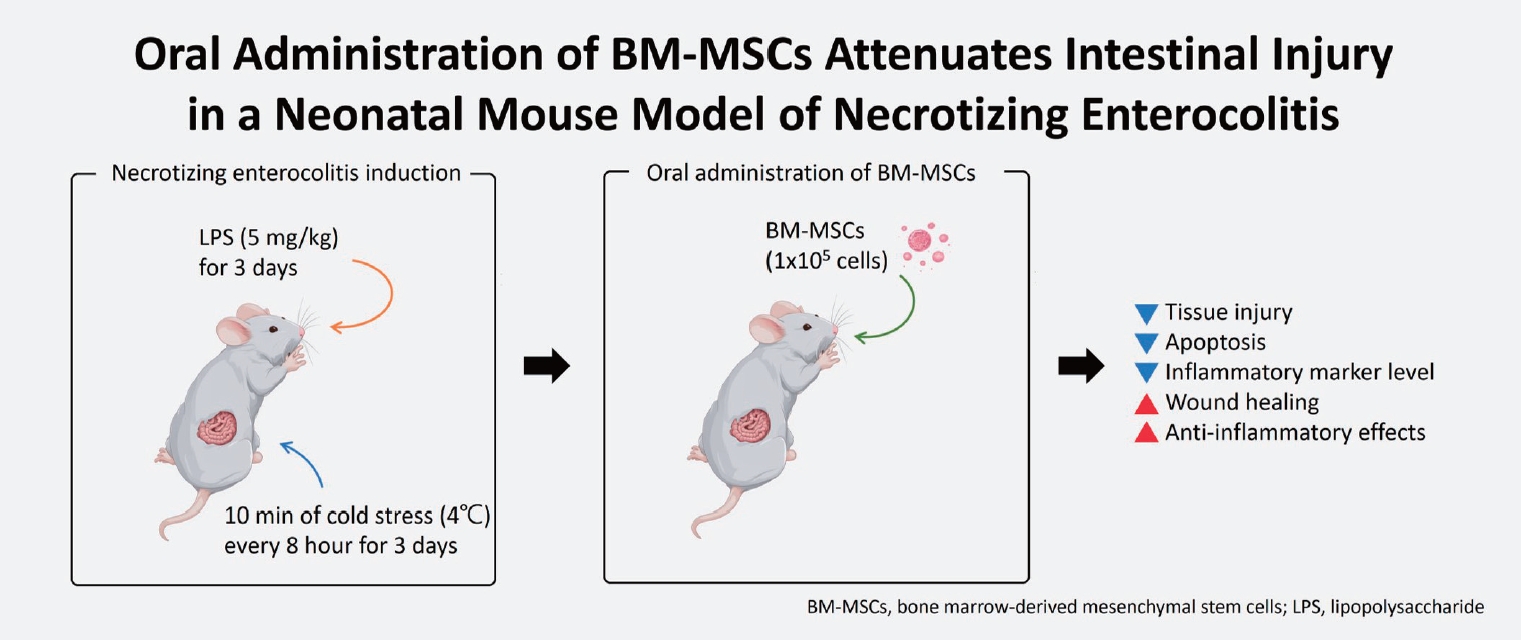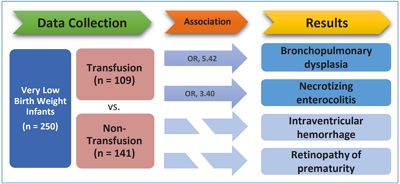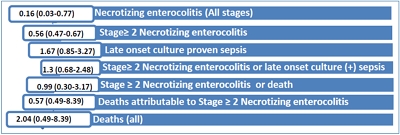Search
- Page Path
-
- HOME
- Search
- Original Article
- Characterization of gut microbiota in very low birth weight infants with versus without bronchopulmonary dysplasia
- Anucha Thatrimontrichai, Manapat Praditaukrit, Gunlawadee Maneenil, Supaporn Dissaneevate, Kamonnut Singkhamanan, Komwit Surachat
-
Background: Gut–lung crosstalk is a pathway involving interactions between the gastrointestinal, respiratory, and immune systems. The immune responses of the gut and lungs are intricately linked, and previous studies demonstrated that the gut microbiota can influence systemic immune responses in the respiratory system as well as bronchopulmonary dysplasia (BPD).
Purpose: To analyze the composition of the gut microbiota in very low... -
DOI: https://doi.org/10.3345/cep.2024.01718 [Accepted]
- Neonatology (Perinatology)
- Short-term outcomes of oropharyngeal administration of colostrum in preterm neonates: a double-blind placebocontrolled randomized trial
- Ameneh Lamsehchi, Maryam Shokouhi Solgi, Mohammad Kazem Sabzehei, Behnaz Basiri, Elahe Talebi Ghane, Kiana Kimiaei Asadi, Sina Azadnajafabad
- Clin Exp Pediatr. 2025;68(1):73-79. Published online October 31, 2024
-

Question: What are the short-term outcomes of oropharyngeal administration of colostrum (OAC) in preterm neonates?
Finding: This study demonstrated the significantly lower rates of necrotizing enterocolitis, clinically suspected sepsis, shorter hospital stay, period to full enteral feeding, and antibiotic therapy period in the OAC group.
Meaning: This trial may further expand the clinical application of OAC in premature infants to reduce their length of hospital stay and complications.
- Oral administration of bone marrow-derived mesenchymal stem cells attenuates intestinal injury in necrotizing enterocolitis
- Yeong Seok Lee, Yong Hoon Jun, Juyoung Lee
- Clin Exp Pediatr. 2024;67(3):152-160. Published online February 19, 2024
-

Question: What is the optimal dose of bone marrow-derived mesenchymal stem cells (BM-MSCs) for treating necrotizing enterocolitis (NEC), and is orally administered BM-MSC effective?
Findings: High (1×106 cells) or multiple BM-MSC doses showed similar effects as low (1×105 cells) doses of intraperitoneally administered BM-MSCs. Furthermore, orally administered BM-MSCs were as effective as intraperitoneally administered BM-MSCs.
Meaning: Orally administered low-dose BM-MSCs are a potential treatment for NEC.
- Effect of red blood cell transfusion on short-term outcomes in very low birth weight infants
- Eui Young Lee, Sung Shin Kim, Ga Young Park, Sun Hyang Lee
- Clin Exp Pediatr. 2020;63(2):56-62. Published online February 6, 2020
-

Question: Does RBC transfusion affect the short-term outcomes of VLBW infants?
Finding: The results showed that RBC transfusion was significantly related to the incidence of BPD (OR, 5.42; P<0.001) and NEC (OR, 3.40; P=0.009).
Meaning: Careful consideration of the patient’s clinical condition and appropriate guidelines is required before administering RBC transfusions.
- Synbiotics use for preventing sepsis and necrotizing enterocolitis in very low birth weight neonates: a randomized controlled trial
- Ozge Serce Pehlevan, Derya Benzer, Tugba Gursoy, Guner Karatekin, Fahri Ovali
- Clin Exp Pediatr. 2020;63(6):226-231. Published online February 5, 2020
-

Background: Probiotics and prebiotics have strain-specific effects on the host. Synbiotics, a mixture of probiotics and prebiotics, are proposed to have more beneficial effects on the host than either agent has alone.
Purpose: We performed a randomized controlled trial to investigate the effect of Lactobacillus and Bifidobacterium together with oligosaccharides and lactoferrin on the development of necrotizing enterocolitis (NEC) or sepsis...
- The relation between serum levels of epidermal growth factor and necrotizing enterocolitis in preterm neonates
- Heba Mostafa Ahmed, Nsreen Mostafa Kamel
- Clin Exp Pediatr. 2019;62(8):307-311. Published online March 15, 2019
-

Purpose: Necrotizing enterocolitis (NEC) is one of the most serious complications of prematurity. Many risk factors can contribute to the development of NEC. The epidermal growth factor (EGF) plays a major role in intestinal barrier function, increases intestinal enzyme activity, and improves nutrient transport. The aim of this study was to assess the role of epidermal growth factor in the...
- Review Article
- Neonatology (Perinatology)
- Fetal and preterm infant microbiomes: a new perspective of necrotizing enterocolitis
- Yong-Sung Choi, In Gyu Song
- Clin Exp Pediatr. 2017;60(10):307-311. Published online October 20, 2017
-
Necrotizing enterocolitis (NEC) is a devastating condition of hospitalized preterm infants. Numerous studies have attempted to identify the cause of NEC by examining the immunological features associated with pathogenic microorganisms. No single organism has proven responsible for the disease; however, immunological studies are now focused on the microbiome. Recent research has investigated the numerous bacterial species residing in the body...
- Necrotizing enterocolitis in newborns: update in pathophysiology and newly emerging therapeutic strategies
- Young Youn Choi
- Clin Exp Pediatr. 2014;57(12):505-513. Published online December 31, 2014
-
While the survival of extremely premature infants with respiratory distress syndrome has increased due to advanced respiratory care in recent years, necrotizing enterocolitis (NEC) remains the leading cause of neonatal mortality and morbidity. NEC is more prevalent in lower gestational age and lower birth weight groups. It is characterized by various degrees of mucosal or transmural necrosis of the intestine....
- Original Article
- Fecal calprotectin concentration in neonatal necrotizing enterocolitis
- Jung Min Yoon, Ju Yi Park, Kyung Ok Ko, Jae Woo Lim, Eun Jeong Cheon, Hyo Jeong Kim
- Clin Exp Pediatr. 2014;57(8):351-356. Published online August 25, 2014
-
Purpose Among the many factors associated with acute intestinal mucosal infection, numerous studies have proposed the usefulness of fecal calprotectin. The aim of this study was to evaluate the usefulness of fecal calprotectin in the diagnosis of necrotizing enterocolitis (NEC).
Methods We collected 154 stool samples from 16 very low birth weight and premature newborns at the Konyang University Hospital neonatal intensive care...
- Analysis of the association between necrotizing enterocolitis and transfusion of red blood cell in very low birth weight preterm infants
- Seon-Yeong Bak, Sihyoung Lee, Jae-Hong Park, Kyu-Hee Park, Ji-Hyun Jeon
- Clin Exp Pediatr. 2013;56(3):112-115. Published online March 18, 2013
-
Purpose To investigate the association between necrotizing enterocolitis (NEC) and red blood cell transfusions in very low birth weight (VLBW) preterm infants.
Methods We studied were 180 VLBW preterm infants who were admitted to the neonatal intensive care unit of CHA Gangnam Hospital from January of 2006 to December of 2009. The subjects were divided into 2 groups: an NEC group (greater than...
- Review Article
- An update on necrotizing enterocolitis: pathogenesis and preventive strategies
- Jang Hoon Lee
- Clin Exp Pediatr. 2011;54(9):368-372. Published online September 30, 2011
-
Necrotizing enterocolitis (NEC) is one of the most critical morbidities in preterm infants. The incidence of NEC is 7% in very-low-birth-weight infants, and its mortality is 15 to 30%. Infants who survive NEC have various complications, such as nosocomial infection, malnutrition, growth failure, bronchopulmonary dysplasia, retinopathy of prematurity, and neurodevelopmental delays. The most important etiology in the pathogenesis of NEC...
- Original Article
- Apoptosis and upregulation of TNF-α and TRAIL receptor 1 (DR4) in the pathogenesis of food protein-induced enterocolitis syndrome
- Jin-Bok Hwang, Sang Pyo Kim, Yu Na Kang, Seong-Ryong Lee, Seong-Il Suh, Taeg Kyu Kwon
- Clin Exp Pediatr. 2010;53(4):525-531. Published online April 15, 2010
-
Purpose : Expression levels of tumor necrosis factor (TNF)-α expression on the mucosa of the small intestine is increased in patients with villous atrophy in food protein-induced enterocolitis syndrome (FPIES). TNF-α has been reported to induce apoptotic cell death in the epithelial cells. We studied the TNF family and TNF-receptor family apoptosis on the duodenal mucosa to investigate their roles in the pathogenesis... -
- Analysis of prognostic factors of laparotomy for necrotizing enterocolitis in extremely low birth weight infants
- Jin Kyu Kim, Yi Sun Kim, Hye Soo Yoo, So Yoon Ahn, Hyun ju Seo, Seo Heui Choi, Soo Kyung Park, Yu Jin Jung, Myo Jing Kim, Ga Won Jeon, Soo Hyun Koo, Kyung-Hoon Lee, Yun Sil Chang, Won Soon Park
- Clin Exp Pediatr. 2010;53(2):167-172. Published online February 15, 2010
-
Purpose : With improved survival of extremely low birth weight infants (ELBWI), there is an increase in the incidence of necrotizing enterocolitis (NEC) requiring laparotomy, and the risk of morbidity and mortality in these ELBWI is increased. Thus, we determined the prognostic factors in ELBWI who underwent laparotomy for NEC. Methods : We retrospectively reviewed the medical records of 35 ELBWI... -
- Gastrointestinal surgery in very low birth weight infants : Clinical characteristics
- Ji Eun Kim, Hye Soo Yoo, Hea Eun Kim, Soo Kyoung Park, Yoo Jin Jeong, Seo Heui Choi,, Hyun Joo Seo, Yun Sil Chang, Jeong Meen Seo, Won Soon Park, Suk Koo Lee
- Clin Exp Pediatr. 2009;52(3):295-302. Published online March 15, 2009
-
Purpose : To report our experience of gastrointestinal (GI) operations (OP) performed in very low birth weight infants (VLBWI) and to evaluate their clinical characteristics. Methods : Among the 1,117 VLBWI admitted to the SMC neonatal intensive care unit from November 1994 to February 2007, the medical records of 37 infants who underwent GI OP (except inguinal hernia OP) and 1,080... -
- Rotavirus-associated neonatal necrotizing enterocolitis
- Hyun Joo Seo, Yu Jin Jung, Soo Kyung Park, Seo Hui Choi, Ji Hyuk Lee, Myo Jing Kim, Yun Sil Chang, Won Soon Park
- Clin Exp Pediatr. 2009;52(1):56-60. Published online January 15, 2009
-
Purpose : This study aimed to test whether rotavirus-associated necrotizing enterocolitis (RV+NEC) produced different clinical findings or outcomes from those of non-rotavirus necrotizing enterocolitis (RV-NEC). Methods : Eight patients from the RV+NEC group and 22 patients from the RV-NEC group diagnosed with modified Bell stage II or higher NEC were selected for this study. Fecal specimens from all infants were tested... -
- Outcome of typhlitis in children with cancer
- Jae Min Lee, Kwang Hae Choi, Jeong Ok Hah
- Clin Exp Pediatr. 2008;51(2):156-161. Published online February 15, 2008
-
Purpose : Neutropenic enterocolitis is an acute, life-threatening inflammation of the small and large bowel, often seen in children with malignancies during periods of prolonged or severe neutropenia. The optimal management for typhlitis in pediatric oncology patients has been debateful between operative and nonoperative approaches. The purpose of this study was to review the outcome of medical management of patients... -
- Case Report
- Primary peritoneal drainage as a treatment for perforated necrotizing enterocolitis with bacterial peritonitis in an extremely low birth weight infant : a case report
- Wook Sun Choi, Il Hong Moon, Jang Hoon Lee, Seung Hwa Lee, Byung Min Choi, Baik-Lin Eun, Young Sook Hong, Joo Won Lee
- Clin Exp Pediatr. 2006;49(7):800-804. Published online July 15, 2006
-
Necrotizing enterocolitis(NEC) is the most common life-threatening surgical emergency in neonates, and remains a major cause of morbidity and mortality. In addition to conventional laparotomy, intraperitoneal drains have been used for the treatment of perforated NEC, especially in extremely low birth weight(ELBW) infants. We report a case of perforated NEC with bacterial peritonitis in an ELBW infant managed with primary... -
- Original Article
- Risk factors and clinical characteristics of necrotizing enterocolitis in full-term newborns
- Young Mi Jeoung, Hyun Gon Je, Sang Hee Son
- Clin Exp Pediatr. 2006;49(5):489-493. Published online May 15, 2006
-
Purpose : The purpose of this study was to determine those factors which could contribute to the development of necrotizing enterocolitis(NEC) in fullterm. Methods : We retrospectively reviewed the medical record of 20 full-terms with NEC(≥modified Bell's staging criteria IIa) who were admitted to the Neonatal Intensive Care Unit of Il Sin Christian hospital from January 1998 through July 2005, and... -
- Risk Factors for the Early Recognition of Cow's Milk Protein-induced Enterocolitis
- Sung Hyuk Lee, Seon Yun Choi, Byung Cheol Lee, Won Joung Choi, Byung Kyu Choe, Yeo Hyang Kim, Una Kang, Sin Kam, Jin-Bok Hwang
- Clin Exp Pediatr. 2005;48(9):991-997. Published online September 15, 2005
-
Purpose : Cow's milk protein-induced enterocolitis(CMPIE) is a symptom complex of vomiting and/ or diarrhea caused by delayed hypersensitivity and may result in serious complications. This study was undertaken to identify high risk factors to facilitate the early recognition of CMPIE. Methods : We reviewed the data of 101 patients, aged 15 to 45 days, admitted due to vomiting and/... -
- Effects of Intestinal Ischemia on Intestinal Mucosal Damage and Effects of Interleukin-10 in Young Murine Model
- Young-Shil Park, Dong-Chul Kim, Chung-Sik Chun
- Clin Exp Pediatr. 2004;47(3):319-324. Published online March 15, 2004
-
Purpose : Intestinal vascular ischemia is the most probable pathogenesis in the development of necrotizing enterocolitis in prematures. The authors studied the histology of intestinal mucosal damage by clamping the superior mesenteric artery in 35 rats, and, analyzed the histologic scores between young rats(I) and adult rats(II) groups according to clamping times(15, 30 and 60 minutes) and compared the effect... -
- Clinical Features of Food Protein-Induced Enterocolitis Syndrome
- Jeong Sik Seo, Hai Lee Chung
- Clin Exp Pediatr. 2001;44(7):758-763. Published online July 15, 2001
-
Purpose : Food protein-induced enterocolitis syndrome(FPIES) is a symptom complex of severe vomiting and diarrhea which is known as a food-related gastrointestinal hypersensitivity disorder without evidence of IgE-mediated sensitivity. We described the clinical characteristics of FPIES in young infants. Methods : Twenty-eight patients, aged 7 to 120 days, were included who were diagnosed as FPIES by clinical criteria and food challenges.... -
- A Clinical Observation of 23 Cases of Necrotizing Enterocolitis
- Ok Young Kim, Eun Ju Jeong, Min Jeong Kim, Mi Yeon Park, Son Sang Seo
- Clin Exp Pediatr. 1995;38(7):886-894. Published online July 15, 1995
-
Purpose : We observed risk factors, clinical findings, diagnosis and treatment of NEC in 23 cases in order to try to prevent developement of, and improve the prognosis of necrotizing enterocolitis(NEC) in the future. Methods : 23 cases of NEC who were admitted to the NICU of Ilsin Christian Hospital between Jan 1992 and June 1994 were studied. Data about birth... -
- Case Report
- A Case of \Intractable Ulcerating Enterocolitis\" of Infant"
- Ju Young Jeong, Jeong Kee Seo, Kwi Won Park, Je Geun Chi
- Clin Exp Pediatr. 1995;38(2):264-270. Published online February 15, 1995
-
Intractable ulcerating enterocolitis of infancy is uncommon, inhereditary disease characterized by ulcerating stomatitis, severe perianal disease, affecting the whole gastrointestinal tract, mainly colon with flask shaped large ulcer. It was first described by Sanderson et al in 5 cases of infant with intractable diarrhea having above clinical manifestation. It should be differentiated with Crohn's disease and Behcet's disease. We experienced a... -
- A Case of Necrotizing Enterocolitis Associated with Cow and Soy Milk Intolerance
- Sang Soo Roh, Young Il Park, Sang Il Lee
- Clin Exp Pediatr. 1992;35(6):862-866. Published online June 15, 1992
-
A case of necrotizing enterocolitis was associated with cow and soy milk intolerance in a term infant. The infant developed symptoms and radiologic findings-pneumatosis intestinalis and portal vein gas-after ingestion of cow and soy milk. Vomiting and diarrhea recurred with reintroduction of either cow or soy milk several times. The infant remained asymptomatic with a good growth rate on breast... -
- Original Article
- A Case of Acute Mixed Lineage Leukemia (ANLL with TII) with neutropenic Enterocolitis.
- Hyeon Joo Choi, Young Suk Koh, Young Mee Hong, Seung Joo Lee, Kee Suk Hong, Keum Ja Choi
- Clin Exp Pediatr. 1990;33(9):1281-1287. Published online September 30, 1990
-
We report a case of acute mixed lineage leukemia with both lymphoid and myeloid lineage characteristics (ANLL with Til) in a twelve-year-old girl who presented with fever and multiple petechiae. Bone marrow remission was obtained by treatment with acute lymphoid leukemia regiman (CCSG 106A). During induction chemotherapy, the patient was complicated by intestinal perforation due to neutropenic enterocolitis but recovered by surgical intervention and... -
- Neonatal Necrotizing Enterocolitis.
- Min Sook Um, Jae Won Huh, Yun Joo Chung
- Clin Exp Pediatr. 1989;32(4):518-524. Published online April 30, 1989
-
We made a review on the 12 cases of neonatal necrotizing enterocolitis admitted to the nursery of Gospel hospital of Kosin Medical College from September, 1984 to June, 1987 and reseults were; 1) Although there were more infants weighing more than 2500 gm with neonatal necrotizing enterocolitis, the prevalence rate of the disease was higher in low birth weight. 2) The half of term... -
- clinical Observation on Neonatal Necrotizing Enterocolitis(Nec).
- Jung Hwan Choi, Chong Ku Yun
- Clin Exp Pediatr. 1985;28(5):423-434. Published online May 31, 1985
-
A clinnical observation was done on 9 cases of NEC who were admitted to the NICU and Pediatric and Pediatric Surgery Ward, Seoul National University Hospital during the period of 5 years from January 1979 to December, 1984. The results were as follows: 1)Among 9 cases of NEC, LBWI below 2,500 g were 3 cases(33.3%) and premature babies below 38... -
- Neonatal Necrotizing Enterocolitis.
- Shinae Yoo
- Clin Exp Pediatr. 1983;26(4):328-338. Published online April 30, 1983
-
18 cases of neonatal necrotizing enterocolitis, diagnosed during the period of 1975 〜 1981, at eight medical institutions located in Seoul, were studied and analyzed. The literature review on neonatal necrotizing enterocolitis was included. -
- Case Report
- A Case of Yersenia Enterocolitica Enteritis Simulating Shigellosis.
- Hong Jin Kim, Hee Chung Chung, Chul Lee, Pyung Kil Kim, Yun Sub Chung
- Clin Exp Pediatr. 1981;24(5):492-496. Published online May 15, 1981
-
We report a case of gastroenteritis due to Yersinia enterocolitica in a 7month old male infant who was misdiagnosed as shigellosis at onset of illness. He was treated with Gentamicin successfully. A marked improvement was resulted in clinical symptoms and laboratory finding at the time of discharge. It is a second case of Y.enterocolitica which is proved by stool culture... -
-

-
-
8.02023CiteScore94th percentilePowered by
-
Impact Factor3.2
-
- TOPICS
- ARTICLE CATEGORY
- Editorial Office
-
Korean Pediatric Society
#1606 Seocho World Officetel, 19 Seoun-ro, Seocho-ku, Seoul 06732, Korea
Tel: +82-2-3473-7306 Fax: +82-2-3473-7307 E-mail: office@e-cep.org
Clinical and Experimental Pediatrics is an open access journal. All articles are distributed under the terms of the Creative Commons Attribution NonCommercial License (http://creativecommons.org/licenses/by-nc/4.0/)
Copyright © 2025 by Korean Pediatric Society.











